Satellite Imagery as a Valuable Tool for the New Common Agricultural Policy 2023–2027
- Zuzana Hajkova, Content Marketing Coordinator, EUSI
On 1 January 2023, the new Common Agricultural Policy for years 2023–2027 entered into force. Hand in hand with the provided subsidies goes the necessity for monitoring and controls, which falls to the individual Member States. Therefore, an efficient, reliable, and cost-effective source of data is needed. Such source is Very High Resolution (VHR) satellite imagery. It allows you to conduct in-depth analysis of plant and soil conditions, map land use at wide scales with incredible detail and accuracy, and ensure that agricultural goals are being met. Read more about how exactly VHR satellite imagery can assist you with the New CAP – based on our 20 years’ experience with the programme.
Table of Contents
About the new CAP
The new Common Agricultural Policy (CAP) is the EU’s long-standing framework for supporting agriculture and rural development across its member states. The current CAP period, spanning from 2023 to 2027, represents a shift towards a more sustainable and environmentally conscious approach to agricultural practices. It is aiming to support farmers, help tackle climate change, and maintain rural landscapes across the EU. To achieve this, the policy presents 10 key objectives:
- To ensure a fair income for farmers.
- To increase competitiveness.
- To improve the position of farmers in the food chain.
- To take climate change action.
- To promote environmental care.
- To preserve landscapes and biodiversity.
- To support generational renewal.
- To foster vibrant rural areas.
- To protect food and health quality.
- To foster knowledge and innovation.
One of the defining features of the current CAP is its strong emphasis on sustainability and precision agriculture. By leveraging technology, such as remote sensing, the policy aims to optimise resource utilisation, reduce environmental impact, and increase agricultural productivity. Since EUSI has 20 years of experience in assisting member states and other stakeholders with CAP-related activities, as well as the highest-quality satellite imagery, we have established processes that are highly effective in meeting these goals.
The role of satellite imagery in CAP
Satellite imagery plays a crucial role in monitoring and evaluating agricultural activities, enabling more targeted and data-driven decision-making processes. Very High Resolution (VHR) imagery enables the precise mapping of land parcels, crop types, vegetation health, soil moisture and more, allowing for better management of agricultural resources and targeted interventions where needed.
“In optical satellite imagery, Very High Resolution refers to sub-meter resolution. For precise mapping and crop identification, you need 30–50 cm resolution.”
Benjamin Schumann, Earth Observation Support Specialist at EUSI
The integration of satellite data into the CAP’s implementation framework is expected to increase transparency, accountability, and the overall effectiveness of the policy’s measures. By providing comprehensive and up-to-date information, VHR satellite imagery empowers stakeholders, from policymakers to farmers, to make informed decisions and adapt their practices accordingly.
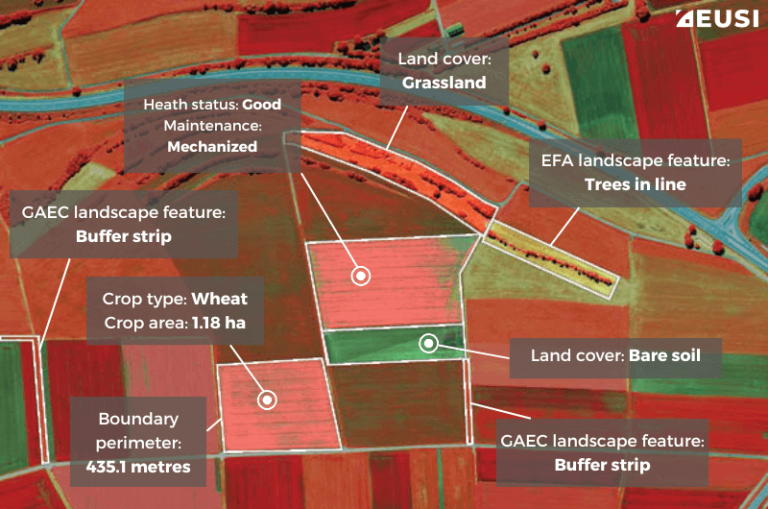
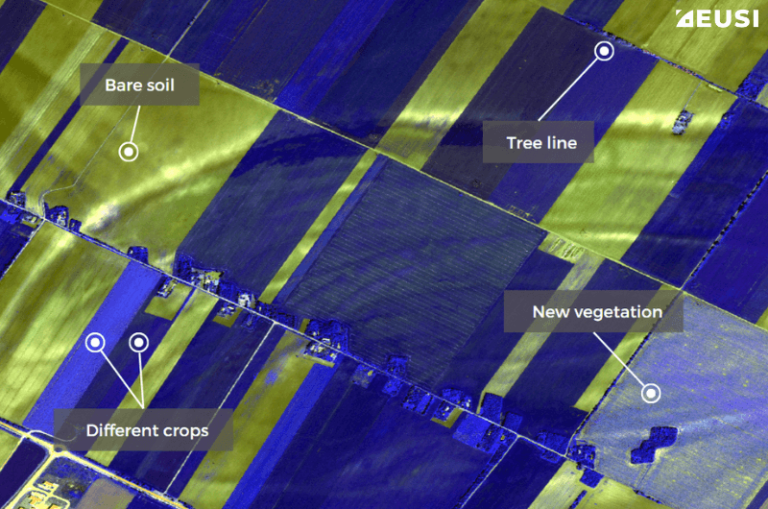
Having extensive experience with CAP and related programmes, we have found VHR satellite imagery especially helpful for these applications:
- vegetation classification
- soil analysis
- large-scale collections
- landscape features and biodiversity
- CwRS (Controls with Remote Sensing) programme
Vegetation classification: learn the type, health and age of plants from a single image
You can use 8-band satellite imagery to accurately classify crops based on their type, health, and growth stage, and utilise this data for the distribution and control of financial support from the EU. How does it work?
8-band imagery
Human eye can see the colour bands in the wavelength spectrum of 400–700 nm (nanometres). However, satellite sensors can display more; they show the wavelengths that are invisible to human eyes, such as near-infrared or red edge. While some satellite providers deliver imagery with four bands, EUSI is the only provider in Europe and North Africa who offers eight bands. (Additionally, EUSI delivers bands captured in the short-wave infrared (SWIR) domain, which is valuable for soil analysis – read more about it later in the article.)
- Human eye: the visible spectrum – coastal, blue, green, yellow, red
- 4-band imagery: blue, green, red, and NIR1 (near-infrared)
- 8-band imagery: coastal, blue, green, yellow, red, red-edge, NIR1, NIR2
- SWIR: 8 bands in the short-wave infrared spectrum
In the image below, move the slider to compare a 4-band image (red and NIR1) and an 8-band image (red edge and NIR1):
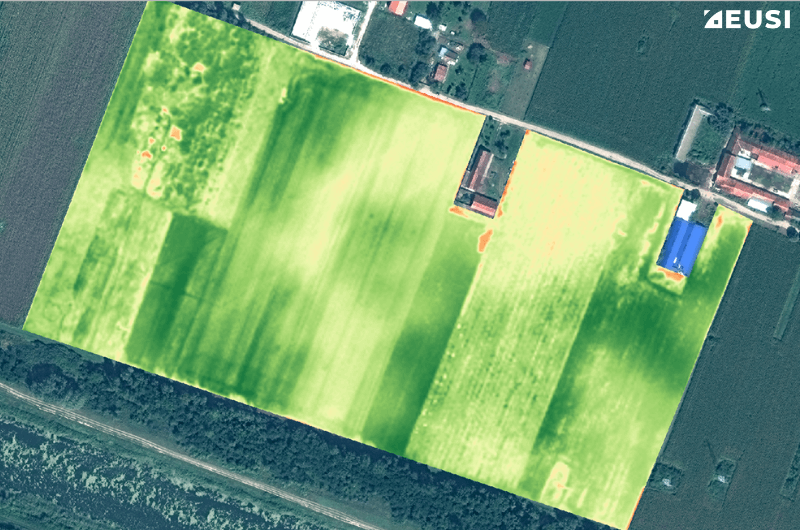
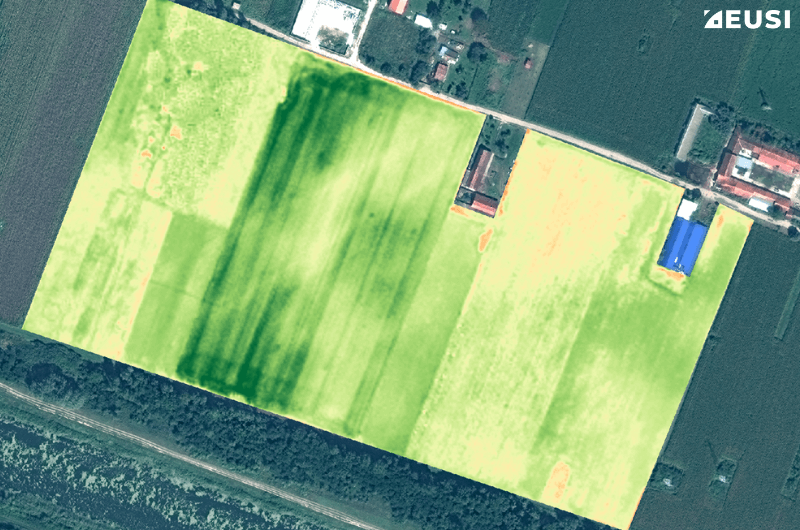
The 8-band image penetrates the vegetation deeper and is more sensitive to plant stress. Satellite image © 2024 Maxar Technologies Provided by European Space Imaging
8-band satellite imagery for vegetation classification
When a plant is illuminated by the sun, part of the energy is absorbed and part is reflected, which we can represent by a curve called a spectral signature. The spectral signature is visible only in multispectral satellite imagery.
For each plant, the signature is slightly different, depending on chlorophyll activity, plant type, age, and health, allowing you to determine the characteristics of crops important for subsidy controls. However, it is strongly dependent on location – it will differ across terrain types, altitudes, and geographical regions. For example, in one area, bright red might mean strong and healthy plants, whereas in another area, bright red might signify trees attacked by bark beetle. Therefore, in order to conduct vegetation classification, you must be familiar with the specific region and always combine multispectral imagery with a ground sample.
Thanks to this, you gain objective and accurate information about plant species and field sizes. This data can be used to distribute subsidies and control farmers’ declarations in a precise and discreet way, without the farmer knowing they are being controlled.
See the image below to compare different resolutions and 4 vs 8 bands:
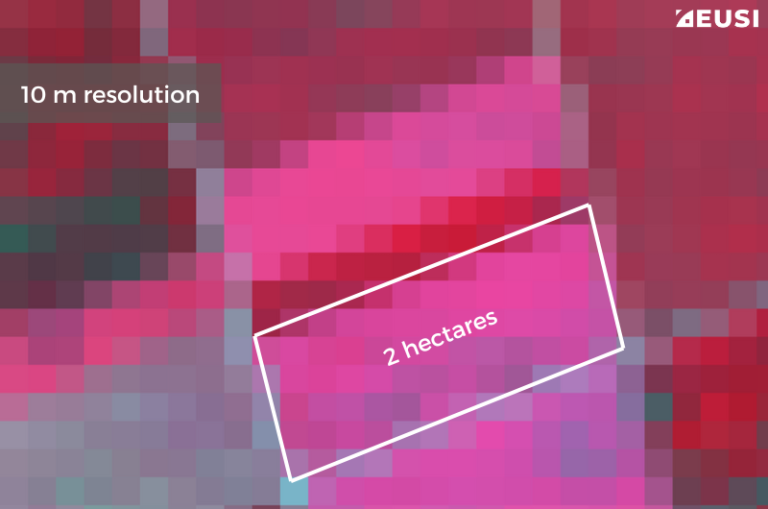
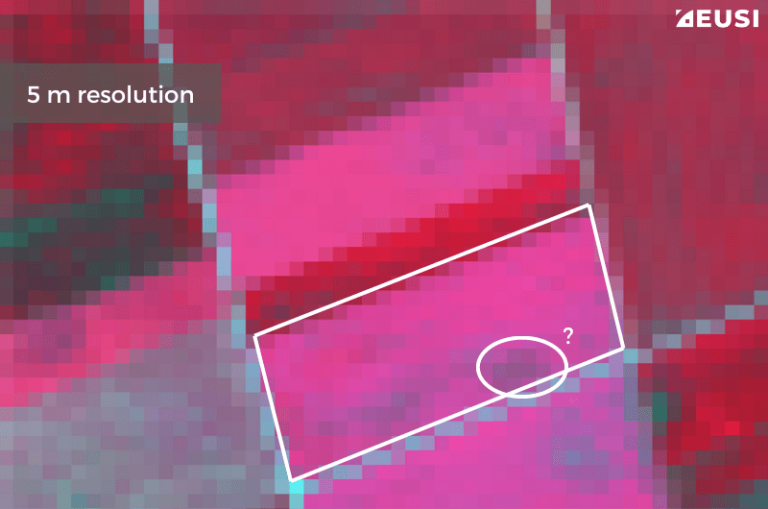
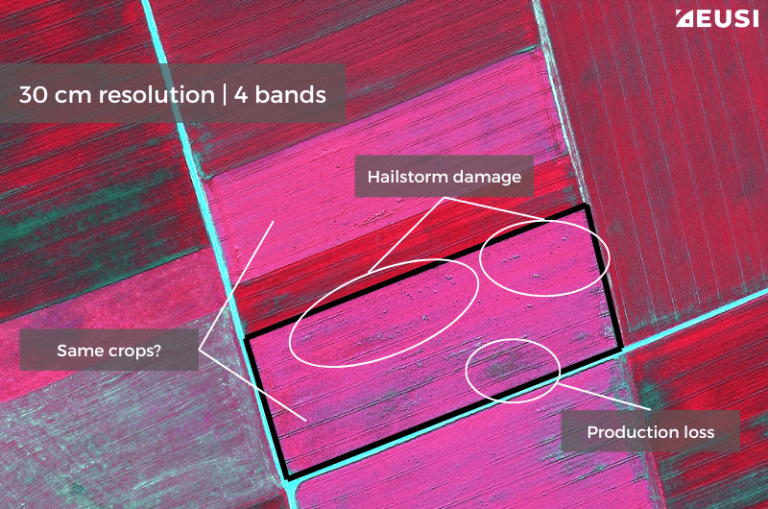
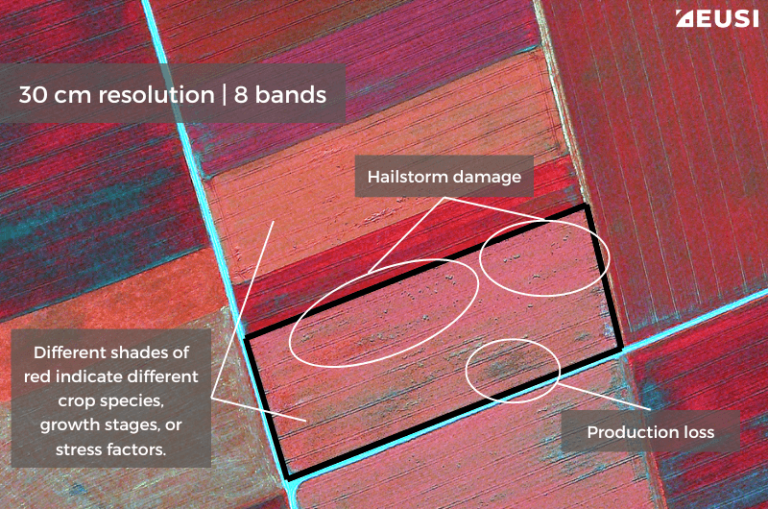
To carry out controls, you upload the results of image analysis in a database which already contains information based on what the farmers declared. The database will crosscheck the data and notify you if there is a discrepancy – in which case you perform further checks like field visits. This method is more accurate, objective, and discreet than relying on the manual control of farmers’ declarations.
Analysing soil with SWIR imagery: moisture, health, and carbon content
Just like 8-band imagery, SWIR (Short-Wave InfraRed) satellite images reveal wavelengths that are invisible to the human eye. SWIR can be used to monitor soil moisture content, which is crucial for agriculture. Not only because the shortage or overabundance of water may mean the plants will die, but also because knowing the levels of soil moisture can help predict natural disasters, manage irrigation, determine whether a field is prepared for agricultural processing, and further optimise farming activities.1
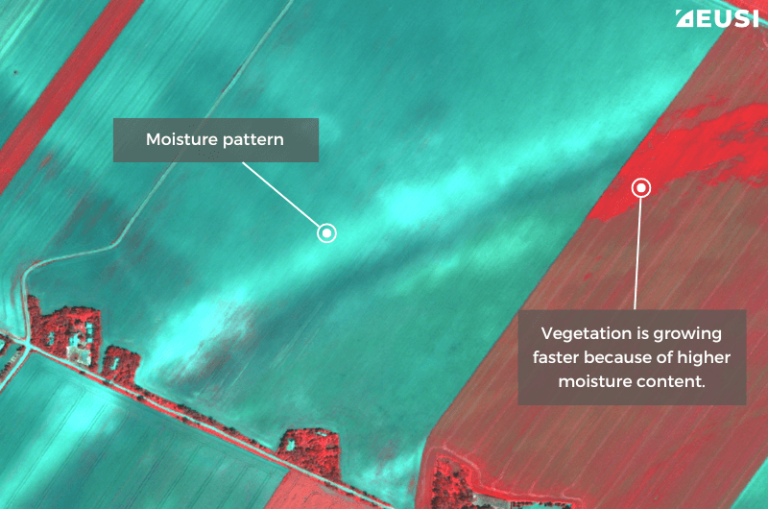
8-band satellite imagery revealing soil moisture. Satellite image © 2024 Maxar Technologies Collected by European Space Imaging
Why not just use soil moisture sensors? The advantage of satellite imagery is that it can map large areas in a single image, allowing you to replace physical soil analysis with a faster and more economical solution.
Multispectral imagery shows soil organic carbon levels
Furthermore, multispectral imagery is a valuable tool for topsoil mapping. By analysing multispectral imagery, scientists can map soil organic carbon levels, nutrient concentrations, and other vital soil traits with incredible accuracy and detail.
Soil organic carbon (SOC) is a key indicator of soil health and fertility. Higher SOC levels are associated with better soil structure, water retention, nutrient cycling, and productivity for crops. Thanks to SOC mapping, farmers can identify areas prone to degradation or in need of carbon sequestration efforts, optimise fertiliser inputs, and comply with regulations. That leads to reducing not only costs but also agricultural impacts.2
Satellites are especially valuable for this application thanks to two factors:
- high revisit rate (the newly launched Maxar WorldView Legion satellites significantly increase the revisit rate, making it possible to collect the area even multiple times a day)
- unprecedented spatial resolution (3.7 metres SWIR with the Maxar constellation, or pan-sharpened multispectral up to 30 cm).
Large-scale collections with near real-time delivery
For region- or even country-wide collections, remote sensing is a cost-effective method that can cover a large area, including a large number of small zones, in a matter of minutes. For example, the Maxar WorldView-3 satellite can collect over 7,000 km2 in a single pass. That’s an image 66 km wide, stretching all the way from the Italian cities of Milan to Genoa, from Salzburg to Linz in Austria, or from Oxford to Cambridge in the UK.
The large image strips and quick delivery times mean that you can receive all your data within important growth cycles. Whereas with aerial or drone imagery you have to stitch together images collected at different times and during different weather conditions, satellites bring a homogenous overview.
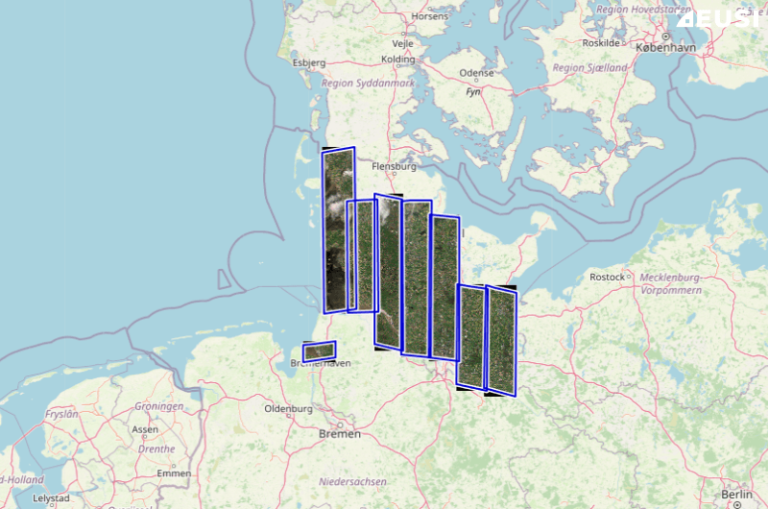
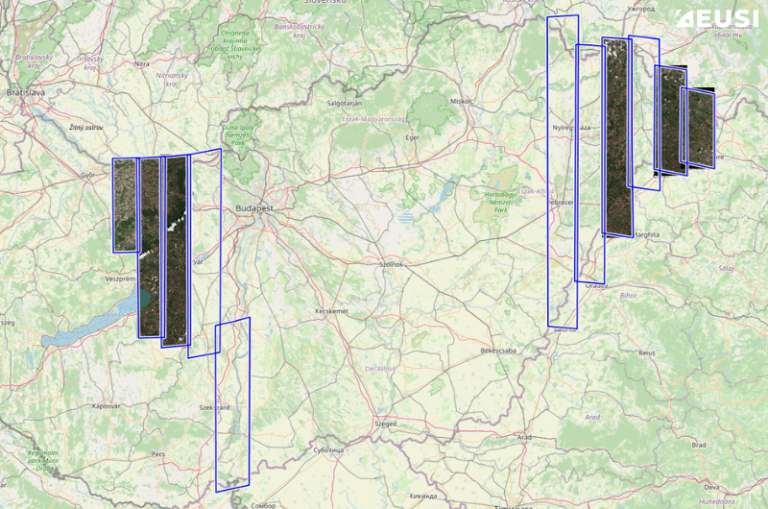
The imagery is directly downlinked in near real-time and available within hours through our recently upgraded ground station in Munich, Germany. Flexible planning can be adjusted up to 15 minutes before each collection including change of AOI and sensor, and priority tasking can be activated for rapid collection. We guarantee a 15% or lower cloud cover.
Using Maxar’s top-of-the-class satellites, we offer resolutions up to native 30 cm. In these VHR images, you can see details such as individual plants, hedges, cattle, and field boundaries. With access to a proprietary HD technology, imagery can be additionally processed to provide 15 cm resolution over entire strips.
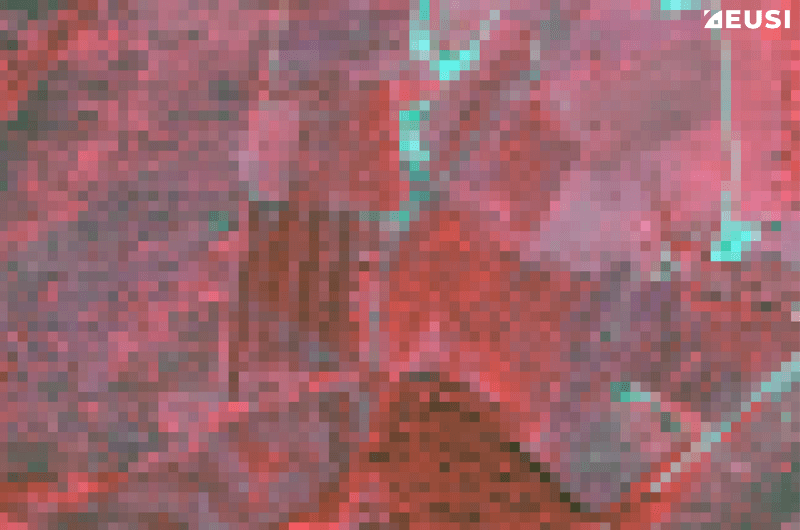
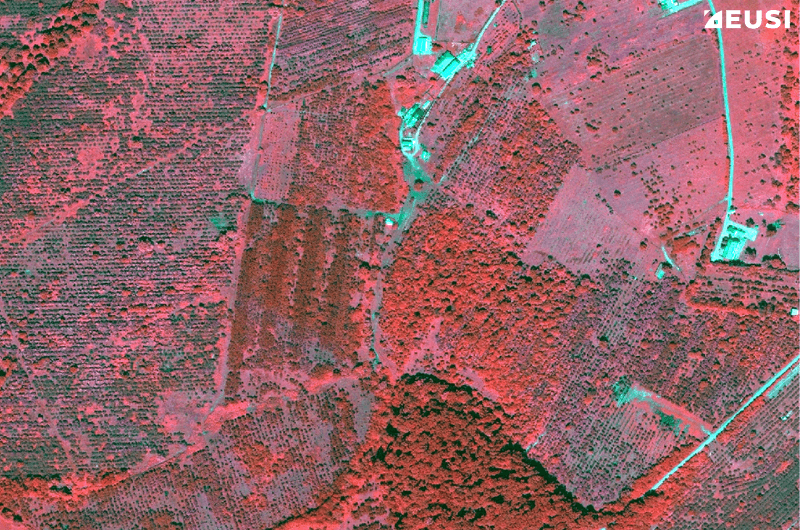
5 m vs 30 cm resolution. In the 30 cm 8-band satellite image, you can determine the number of trees, the size of the crown, different species, and vegetation age. Satellite image © 2024 Maxar Technologies Provided by European Space Imaging
Our VHR satellite imagery can support you in accurately identifying Good Agricultural and Environmental Conditions (GAECs), crop type, land cover type, land maintenance, landscape elements and landscape feature quantification. In addition, our data can be used for the independent control of your LPIS reference system.
Monitoring landscape features and biodiversity
One of the key objectives of CAP is to contribute to reversing biodiversity loss. For that, collaboration with farmers is needed. “Farmers play a vital role in preserving biodiversity. They are among the first to feel the consequences when biodiversity is lost but also among the first to reap the benefits when it is restored,” says the EU Biodiversity Strategy for 2023. “At the same time, certain agricultural practices are a key driver of biodiversity decline. This is why it is important to work with farmers to support and incentivise the transition to fully sustainable practices.”
The target is to bring back at least 10% of agricultural area under high-diversity landscape features. Farmers can achieve that by (re)introducing riparian vegetation, hedges, buffer strips, terrace walls, or non-productive trees, or ponds. Numbers speak clearly:
- Restoring only 15% of ecosystems in priority areas can cut extinctions by 60%.3
- Forest restoration and better farm practices could curb the pollution of water supplies for 81% of cities globally.4
- Approximately 12 million hectares of severely eroded croplands in the EU contribute to an annual loss in agricultural productivity of 1.25 billion Euros.5
VHR (Very High Resolution) satellite imagery can significantly help with monitoring the implementation of sustainable practices and evaluating their impact. In images with 30 cm resolution, you can see individual trees, vegetation patches, small water bodies, or migration corridors for wildlife species.
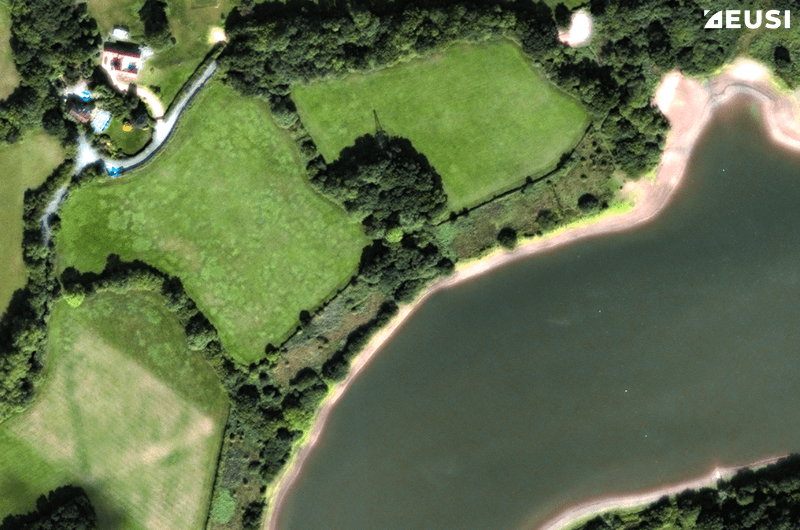
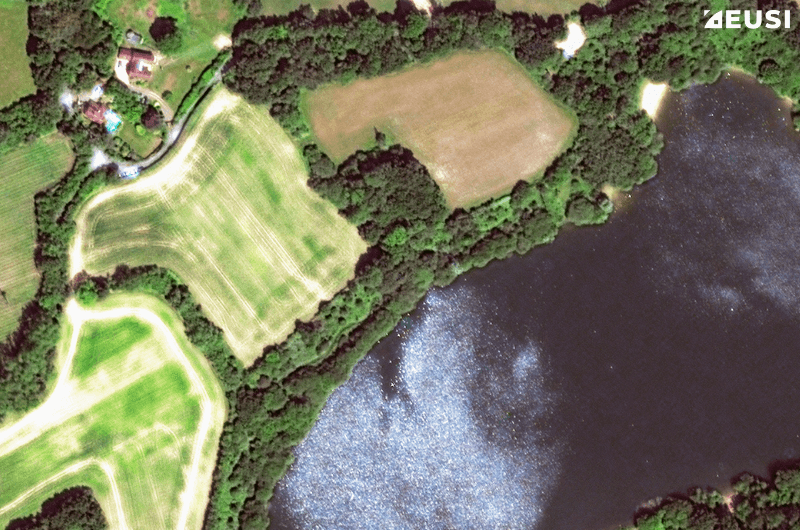
These two images at 40 cm resolution show the change in vegetation in High Weald National Landscape, UK. Satellite image © 2024 Maxar Technologies Provided by European Space Imaging
“At least 25% of the EU’s agricultural land must be organically farmed by 2030.”
EU Biodiversity Strategy for 2030
Example from Romania
To protect the sensitive habitat of Romania’s Hartibaciu region, Muncons SRL deployed WorldView-2 high-resolution satellite imagery with an integrated GIS solution and web portal to develop a land management plan. 8-band images were used for automatic and semi-automatic habitat classification, including land, water courses, infrastructure, and developed areas such as buildings, roads and industrial zones, and the supplemental web portal included interactive maps of endangered species distribution, areas of vegetation, agriculture, preservation lands and environmental hazards. Thanks to this solution, the World Wildlife Fund was able to save a significant amount of money because fewer field specialists were required to complete the project. Read the case study.
CwRS Programme: Controlling agricultural subsidies
The European Commission has encouraged using Controls with Remote Sensing (CwRS) to control agricultural subsidies granted under the EC’s Common Agricultural Policy. After the real-life evaluation in 2003 and the successful operation in 2004, the EC’s Joint Research Centre now provides VHR satellite data to EU Member States for their CwRS-based subsidies.
EUSI helped initiate the programme in 2004 and has been a reliable contributor since, with success rates close or equal to 100% every year. We have the benefit of operating our own ground station in Munich, Germany, which, in combination with manual satellite tasking based on real-time weather conditions, leads to the speedy delivery of data for distribution to the EU Member State administrations. We are able to deliver the imagery in near-real time, thereby assisting and enabling the administrations to manage their own deadlines.
- In 2013, we had 100% success over a total of 213 control sites. About half the sites were collected within 7 days of the collection window start time, and the rest within 15 days of the window opening.
- In 2015, the demand for imagery for the CwRS programme increased by more than 40% reaching 497,000 km² across 950 control sites. We collected more than half of the sites within 14 days of the window opening and about one third within 7 days – with a 100% success rate.
- In 2017, cloudy weather over Latvia, the UK, and Ireland made the operation particularly challenging. But once again, EUSI finalised the collection of nearly half a million square kilometres of satellite imagery for the CwRS programme with a 100% success rate.
- In 2019, EUSI had 714 acquisition windows for each of the 628 agricultural zones spread all over Europe using Maxar‘s WorldView-2, WorldView-3 and GeoEye-1 sensors. Despite weather challenges, we managed to collect images for approximately 63% of the zones completely cloud-free.
- Acquiring a total of 361,991 square kilometres, 2020 was the fourth year in a row that we proficiently completed the collection with a success rate of 100%.
- In 2021, manual weather assessments contributed to the high success rate of the collection over zones with an average cloud cover of 0.6%.
“Direct tasking allows EUSI to minimise cloud cover, increase collection efficiency, enable customer flexibility and shorten delivery times.”
Nicole Enghuber, Earth Observation Support Specialist at EUSI
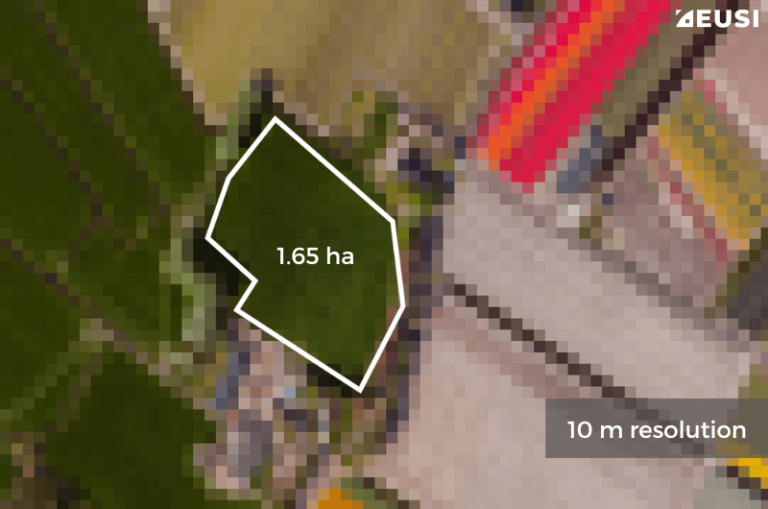
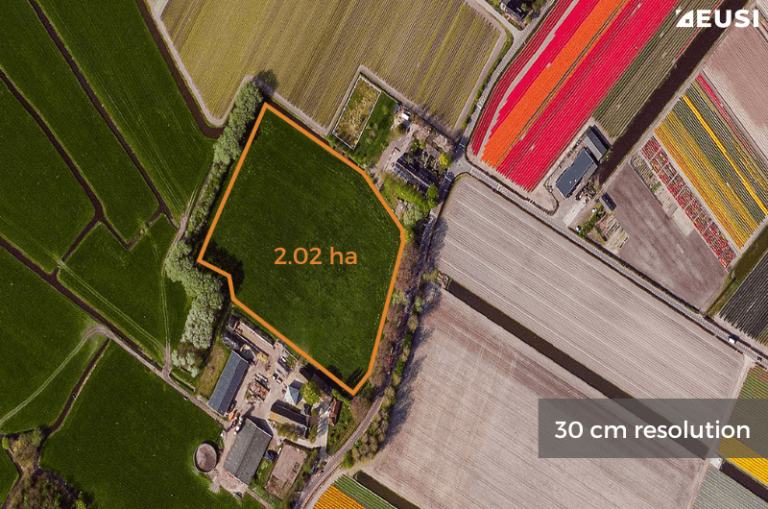
From 2023, the responsibility to operate CwRS On-the-Spot-Checks falls to the Member States. Our products and expertise can assist you with:
- filling missing data gaps, particularly where small parcels (<0.2 ha) are concerned
- quality control of the Sentinel-based Area Monitoring System
- cost-effective and efficient solution to updating the national LPIS (Land Parcel Identification Systems)
- guidance with the definition of imagery requirements
- feasibility studies to ensure that the imagery complies with JRC standards
- assurance of check methods
Use our 20 years of experience with CAP to your advantage
Since 2004, EUSI has had an expert team of remote sensing specialists dedicated to the CAP’s CwRS and LPIS QA programmes. We have acquired a vast amount of knowledge of the inner workings of these programmes and are familiar with the requirements of the Member States and Paying Agencies. In addition to the high-quality standards of our imagery, we can provide consultancy support and guide you in the areas of:
- definition of image requirements
- feasibility studies to ensure that the image will fit your needs and comply with JRC standards
- assist with the assurance of check methods and integration of the data into your inhouse alternative to G⁴CAP
- recommended parameters (resolution, bands, etc.)
A dedicated team will assist you from start to end of the imagery collection and delivery phase, activating priority tasking to ensure that your acquisitions are treated with urgency, and near real-time delivery of the data to meet your project timelines.
“What resolution do you need? Should you use VHR imagery, or is free data from Sentinel enough for your needs? Would 8-band or SWIR work better? You can ask us, we will be happy to guide you through the process.”
Benjamin Schumann, Earth Observation Support Specialist at EUSI
Key takeaways
- You can use 8-band satellite imagery to accurately classify crops based on their type, health, and growth stage.
- SWIR imagery is an effective tool to measure soil moisture, health, carbon content, and other parameters.
- Satellites can cover large areas – for example Maxar WorldView-3 can collect up to 7,000 km2 in one pass. Our data is available within hours, and offers resolutions up to 15 cm HD.
- You can use satellite imagery to monitor biodiversity and ecosystem restoration. 30 cm resolution allows you to see individual trees, vegetation patches, small water bodies, or migration corridors for wildlife species.
- EUSI helped initiate the CwRS programme in 2004 and has been a reliable contributor since, with success rates close or equal to 100% every year.
- We have a dedicated team of experts that can assist you with the whole process, from defining the required parameters of imagery and conducting feasibility studies to scheduling the collection and integrating the data into your inhouse alternative to G⁴CAP.
Resources
1 CHERLINKA, Vasyl. Soil Moisture: How To Measure & Monitor Its Level. Online. In: EOS Data Analytics, 20. 9. 2022. Available from: https://eos.com/blog/soil-moisture/
2 TZIOLAS, Nikolaos et al. Soil organic carbon mapping utilizing convolutional neural networks and Earth observation data, a case study in Bavaria state Germany. Geoderma [online]. April 2024, vol. 444, art. 116867. Available from: https://www.sciencedirect.com/science/article/pii/S001670612400096X
3 BECOMING #GENERATIONRESTORATION: Ecosystem restoration for people, nature and climate. Online. In: UN Environment Programme. Available from: https://www.unep.org/interactive/ecosystem-restoration-people-nature-climate/en/index.php
4 COLINA, Anna. This is the decade of Ecology and Action and we are #GenerationRestoration. Online. In: Dendra Systems, 8. 7. 2021. Available from: https://dendra.io/blog/world-environment-day/
5 PANOS, Panagos et al. Cost of agricultural productivity loss due to soil erosion in the European Union: From direct cost evaluation approaches to the use of macroeconomic models. Land Degradation & Development [online]. March 2018, vol. 29, no. 3, pages 471–484. Available from: https://onlinelibrary.wiley.com/doi/full/10.1002/ldr.2879
Related Stories
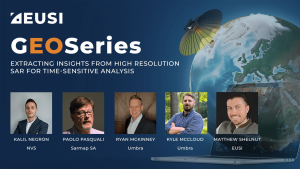
GEOSeries: Extracting Insights From High Resolution SAR Imagery for Time-Sensitive Analysis
In this webinar, industry experts and advanced users of Umbra SAR data showcase how they transform SAR imagery into actionable insights in real-world mapping, monitoring and intelligence applications. See how NV5 and Umbra leverage ENVI SAR Essentials for advanced processing with time-efficient results, converting analytics into valuable intelligence.

Using Satellite Imagery to Build Water Resilience Across Europe
Water across Europe is facing severe pressure. Climate change, urbanisation, agricultural demands and other sources of pollution are threatening water security and creating critical challenges that need to be addressed. We have to act quickly, build stronger systems and create sustainable water resilience practices – so that both natural ecosystems and human communities can thrive. Here is how satellite imagery from EUSI can help.

EUSI and Albedo Partner to Deliver 10 cm Resolution Satellite Imagery to Europe
It is our pleasure to announce the partnership with Albedo, a builder of high-performance spacecraft and the first satellite designed to operate commercially in VLEO (Very Low Earth Orbit). This partnership will bring the world’s highest resolution satellite imagery to the European and North African market.

Updating the Land Parcel Identification Systems in 2025: The Benefits of Using Satellite Images
Agricultural paying agencies across Europe face increasing challenges in maintaining accurate and up-to-date Land Parcel Identification Systems (LPIS), ensuring compliance with the Common Agricultural Policy (CAP) and supporting sustainable agricultural practices.





